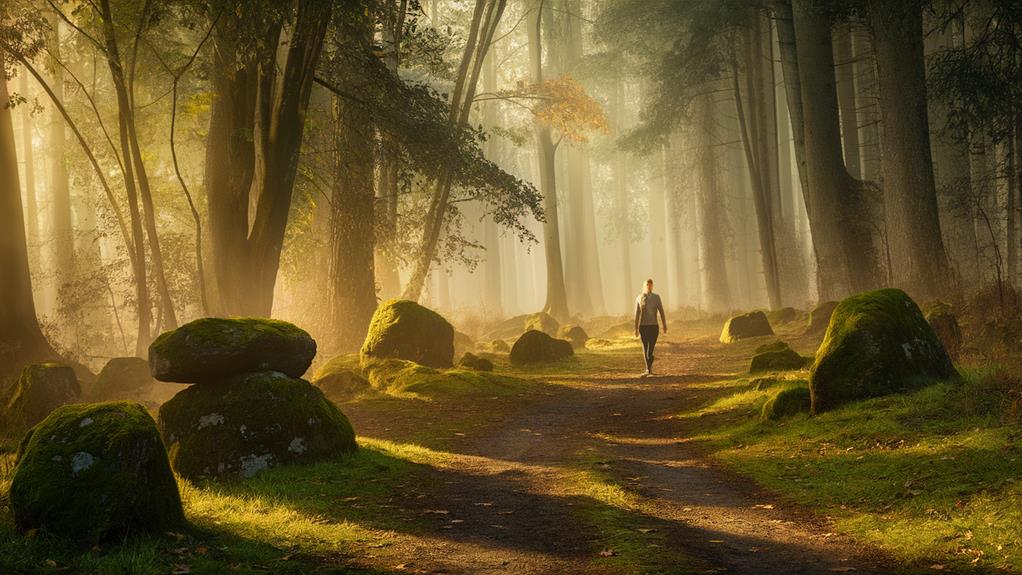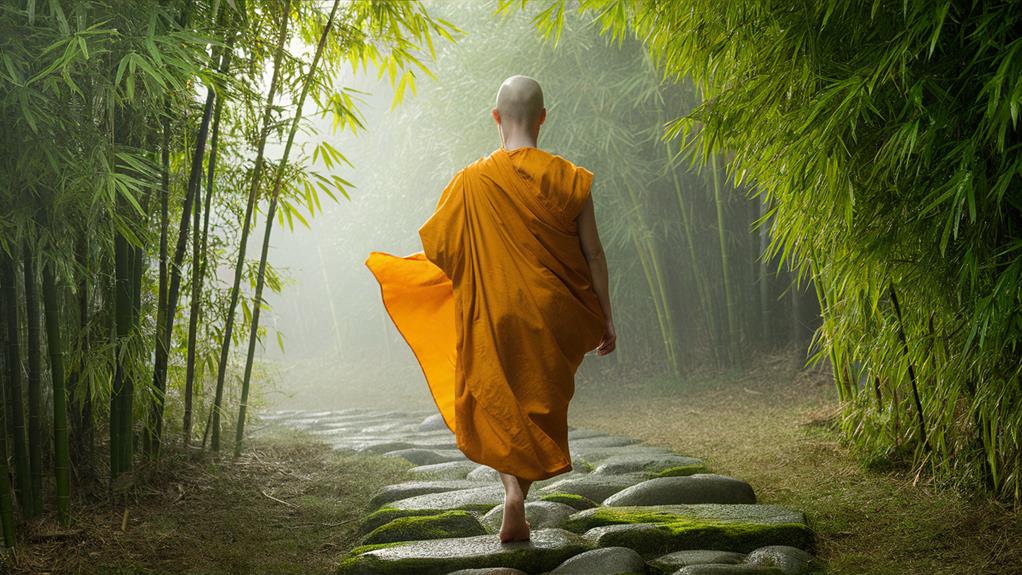Mysticism and the Practice of Walking Meditation
You’ll discover that walking meditation isn’t just about putting one foot in front of the other—it’s an ancient gateway to mystical awareness that transforms ordinary movement into sacred ritual. As you synchronize your breath with each step, you’re participating in a practice that mystics and spiritual seekers have used for millennia to pierce the veil between the mundane and the divine. While modern practitioners often focus on stress reduction and mindfulness, the deeper dimensions of walking meditation hold secrets that can revolutionize your understanding of consciousness and your place in the cosmos. The journey ahead will reveal how this deceptively simple practice opens doors to profound spiritual experiences.
The Ancient Origins

The practice of walking meditation traces its roots back over 2,500 years to Buddhist traditions in ancient India. You’ll find its earliest recorded teachings in the Satipatthana Sutta, where the Buddha instructs his followers to remain mindful of each step, each movement, as they walk their path toward enlightenment.
As you explore deeper into history, you’ll discover that walking meditation wasn’t confined to Buddhism alone. Ancient Greek philosophers, particularly the Peripatetics who followed Aristotle, embraced the profound connection between physical movement and contemplative thought.
They’d traverse the covered walkways of the Lyceum, finding that the rhythm of their steps enhanced their philosophical discourse and inner reflection.
In China’s Chan tradition and Japan’s Zen practices, you’ll encounter kinhin – the art of walking meditation between longer periods of seated contemplation.
This practice emerged from the understanding that you needn’t separate movement from mindfulness. The ancient practitioners recognized that your body’s natural motion could serve as a bridge between the material and spiritual domains, creating a dynamic form of moving meditation that’s as relevant today as it was millennia ago.
Walking Through Sacred Spaces
Sacred pathways within monasteries, temples, and gardens have served as walking meditation spaces for countless generations. As you move through these hallowed grounds, you’ll discover that each step connects you to seekers who’ve walked these same paths throughout history, their collective energy still resonating within ancient stones and weathered wood.
When you enter these sacred spaces, you’re crossing a threshold between the mundane and the divine. The carefully designed pathways – whether they’re stone-laden monastery corridors or intricate garden labyrinths – guide your journey inward.
You’ll notice how the architecture directs your gaze upward toward soaring spires or outward to carefully placed natural elements, each view orchestrated to deepen your contemplative state.
These spaces aren’t merely physical locations; they’re portals to heightened awareness. As you walk, you’re participating in a living tradition where the boundaries between movement and stillness, form and emptiness, begin to dissolve.
The sacred geometry of these spaces creates natural rhythms that sync with your breathing, transforming each step into a bridge between earth and sky.
Mind-Body Connection During Movement

Movement creates a powerful bridge between your thoughts and physical sensations, awakening a deeper awareness of how your mind and body interact. As you place one foot before the other, you’ll notice how each step resonates through your entire being, creating ripples of consciousness that extend from your physical form into the depths of your awareness.
Your breath naturally synchronizes with your stride, establishing a rhythm that dissolves the artificial boundary between mental and physical existence. You’ll discover that thoughts don’t merely float in abstract space – they’re intimately connected to your body’s motion, tension, and release. Each mindful step becomes both an anchor to the present moment and a gateway to deeper understanding.
As you continue your walking meditation, you’re participating in an ancient dance of consciousness and form. Your muscles, bones, and sinews become instruments of awareness, while your mind settles into the gentle cadence of movement.
This integration reveals that you’re not simply a mind directing a body, but rather a unified field of experience where thought and motion, intention and action, flow together in seamless harmony.
Transcendent States While Walking
Footsteps along a quiet path can open doorways to extraordinary states of consciousness. As you walk with mindful awareness, you’ll notice how the rhythmic motion of your feet creates a gentle momentum that carries you beyond ordinary perception into domains of expanded awareness. Each step becomes a gateway through which you can transcend the mundane and touch something vast and timeless.
You’ll discover that walking meditation can induce states where the boundary between self and surroundings begins to dissolve. Your awareness may shift from the physical act of walking to a profound sense of unity with the earth beneath your feet and the air that surrounds you.
Time seems to flow differently here – moments stretch into eternity while hours pass like seconds.
In these transcendent states, you’re likely to experience what mystics have described as “walking between worlds.” Your consciousness expands beyond the narrow confines of everyday thinking, and you’ll find yourself accessing deeper truths that often remain hidden in routine existence.
The path becomes both literal and metaphorical – a bridge between the physical and the sublime.
Nature’s Role in Walking Meditation

Through the embrace of natural settings, walking meditation reaches its fullest potential. You’ll discover that nature serves as both mirror and catalyst, reflecting your inner landscape while drawing you deeper into presence. As you walk among trees, streams, and wild spaces, you’re participating in an ancient dialogue between consciousness and creation, where every step connects you to the earth’s own rhythms and wisdom.
When you practice walking meditation in nature, you’ll notice how the elements become your teachers. The wind’s touch reminds you to stay fluid in your movements, while birdsong pulls your awareness outward then inward in gentle waves. The uneven terrain beneath your feet demands mindful stepping, naturally slowing your pace and deepening your focus.
You’re not just walking through nature; you’re walking with it, allowing its patterns and presence to guide your practice. This communion with the natural world transforms your meditation into something more profound than simple movement or contemplation.
You become part of nature’s endless cycles, joining in its dance of perpetual renewal and timeless being. Your steps merge with earth’s ancient pulse, and you find yourself walking the path of both pilgrim and witness.
Dissolving the Ego Boundary
As you deepen your walking meditation practice, the rigid boundaries of self-identity gradually begin to soften and blur.
You’ll notice how your consciousness expands beyond the usual confines of “I” and “me,” merging with the rhythm of your footsteps and the pulse of the world around you.
What once felt like a distinct separation between inner and outer dimensions now dissolves into a seamless flow of experience.
In this expanded state, you’ll discover that your sense of self isn’t fixed or absolute but rather fluid and interconnected.
The wind that touches your skin, the ground beneath your feet, and the space through which you move become extensions of your awareness rather than separate phenomena.
You’re no longer merely observing your environment; you’re participating in an intimate dance with existence itself.
This dissolution of ego boundaries doesn’t mean losing yourself – instead, it reveals a more authentic way of being.
Through each mindful step, you’re discovering what the mystics have long known: that true freedom lies not in strengthening the ego’s walls, but in allowing them to become permeable, letting your essential nature flow freely between self and world.
Buddhist Walking Meditation Techniques

Buddhist traditions offer several time-tested techniques for walking meditation, each designed to cultivate mindfulness and presence. As you begin, you’ll notice how each step becomes an anchor, drawing you into the eternal now through deliberate, mindful movement.
The traditional kinhin practice invites you to coordinate your breath with your steps, typically moving forward only with each exhalation while maintaining an upright posture and relaxed shoulders.
In the Theravada tradition, you’ll learn to break down each step into distinct phases – lifting, moving, and placing – while mentally noting each movement. This microscopic attention reveals the intricate dance between intention and action, consciousness and form.
You might choose to walk at different speeds, from an extremely slow pace that heightens awareness of subtle bodily sensations to a more natural rhythm that mirrors daily life.
As you practice, you’ll discover how the ground beneath your feet becomes your teacher, each step an opportunity to experience the profound connection between your body and the earth, between movement and stillness, between doing and being.
Walking the Mystical Path
The mystical dimension of walking meditation transcends ordinary awareness, opening doors to profound spiritual insights. As you walk mindfully, you’ll discover that each step becomes a gateway into deeper spheres of consciousness, where the boundaries between self and universe begin to dissolve.
Your footfalls create a rhythm that aligns with the pulse of existence itself, drawing you into communion with something vast and ineffable. You’re not just moving through space; you’re participating in an ancient dance of consciousness.
Each mindful step carries you deeper into the mystery of being, where you’ll encounter the sacred in the simple act of walking. You’ll find that time shifts and expands, creating moments of crystal clarity where you’re fully present yet paradoxically beyond the confines of ordinary experience.
As your awareness deepens, you’ll notice how the ground beneath your feet becomes holy terrain, and your journey transforms into a pilgrimage of the soul. This practice isn’t about reaching a destination but about discovering the profound truth that you’re already home, already complete, in every step you take.
Modern Science Meets Ancient Practice

Recent scientific research validates what practitioners have known for centuries: walking meditation creates measurable changes in the brain and body.
You’ll discover that neuroscientists have documented increased gray matter density in regions associated with emotional regulation and self-awareness, while cardiovascular studies reveal the practice’s ability to lower blood pressure and reduce stress hormones.
As you integrate this ancient wisdom with modern understanding, you’ll find that walking meditation bridges the gap between contemplative traditions and contemporary wellness practices.
EEG readings show enhanced alpha wave activity – similar to that observed in experienced meditators – when you synchronize your breath with your steps. The rhythmic nature of walking meditation activates your parasympathetic nervous system, initiating what scientists call the “relaxation response,” while simultaneously engaging neural pathways that support present-moment awareness.
You’re participating in a practice that’s now scientifically proven to strengthen the brain’s neuroplasticity, fostering improved cognitive function and emotional resilience.
This convergence of ancient wisdom and modern research confirms what contemplative traditions have long maintained: mindful walking isn’t just movement – it’s a profound tool for transformation.
Daily Integration and Practice
Sunlight filters through morning mist as you take your first mindful steps, but walking meditation isn’t limited to serene dawn hours. You’ll find opportunities to practice throughout your day – walking to your car, moving between meetings, or strolling through a grocery store’s aisles. Each step becomes an anchor to the present moment, transforming routine movements into gateways of awareness.
Begin by choosing a comfortable pace that allows you to notice the intricate dance of movement – the heel lifting, the ball of your foot rolling, your toes pressing into the earth. You’ll discover that this practice doesn’t require special clothing or secluded spaces; it flourishes in the midst of your daily life.
Let your breath synchronize naturally with your steps, creating a rhythm that grounds you in the now. As you integrate walking meditation into your routine, you’ll notice subtle shifts in your awareness. Ordinary paths become sacred spaces, and previously mundane moments transform into opportunities for deepening presence.
Your daily walks, whether through city streets or quiet corridors, become pilgrimages of consciousness, each step an invitation to awakening.









